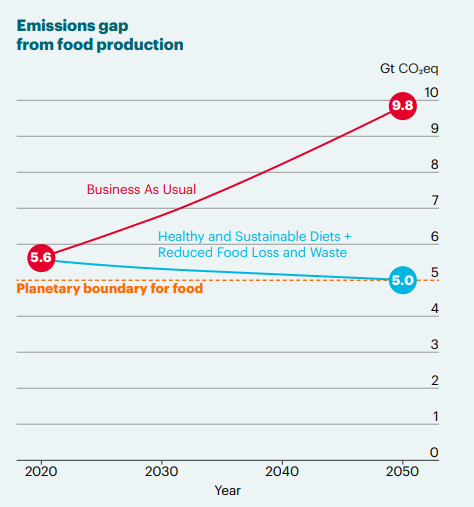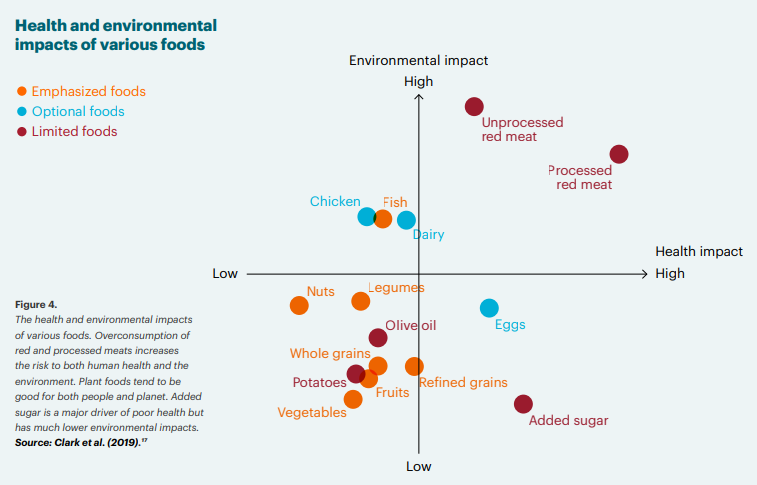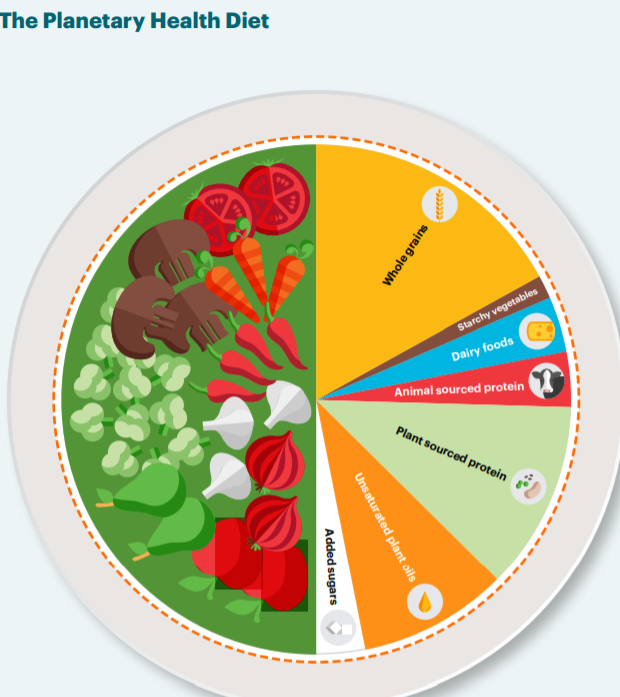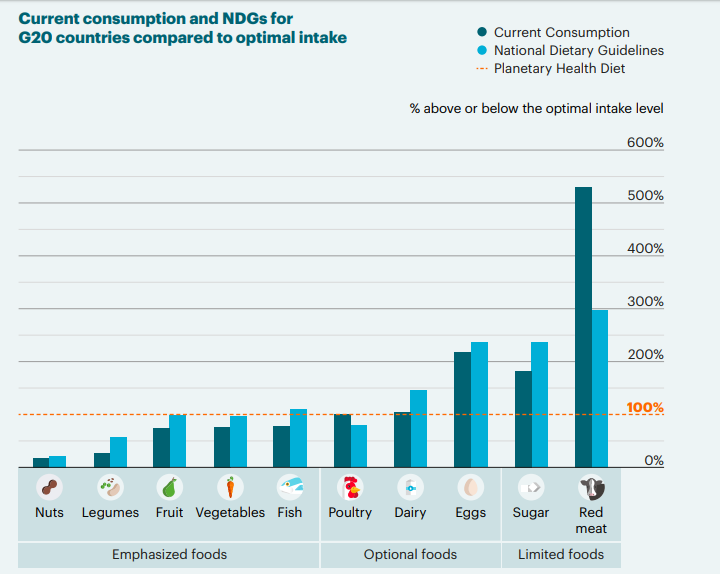Diets for a better future: Rebooting and Reimagining Healthy and Sustainable food systems in the G20
July 13, 2022

Diets for a Better Future is a study conducted by the EAT-Lancet Commission, which investigates current food consumption patterns, the efficacy of national dietary guidelines in G20 countries compared to the Planetary Health Diet and explores the potential for reducing greenhouse gas emissions by shifting toward more healthy and sustainable diets.
The G20 countries consist of 19 countries, including India, plus the European Union (EU28). Collectively, the G20 economies account for around 90% of gross world product, 80% of world trade, two-thirds of the global population, and approximately half of the global land area. These countries also account for over 75% of the global ‘carbon budget’ for food.
This report by Eat Lancet explores some of these pressing issues and presents opportunities for G20 countries to lay the foundation for a sustainable future.
THE CHALLENGE
Food Production
Food production generates about 24% of the annual greenhouse gases (GHG) with livestock production, fertilizer use, food wastage and land conversion being major contributors. This evokes the issues of global warming. There is a need to keep Global Warming well below 2°C to maintain Earth’s stability and reduce catastrophic impacts on human civilization.
If we follow a business-as-usual approach, GHG (Greenhouse Gas) emissions from food production are projected to rise to 9.8 Gt CO2eq (9.8 Giga Tonnes of carbon dioxide equivalent). A shift toward healthy flexitarian diets (such as the Planetary Health Diet) in G20 countries and halving in food loss and waste can help prevent this gap. Global emissions from food consumption must not be greater than 5.0 Gt CO2eq by 2050.

Food Consumption
Consumption patterns of food have also changed. On one hand, the rates of obesity have increased in certain countries, while on the other malnutrition is still prevalent in some countries.
The current consumption patterns of G20 suggest increased consumption of refined carbohydrates, sugars, and red and processed meats. There has been substantial evidence that states that overconsumption of these unhealthy foods leads to greater environmental impact. If this trend is not broken and reversed, emissions from food production will nearly double by 2050. The challenge would therefore be to bring about a change in our diets and be more mindful of its environmental impact.

National Dietary Guidelines
In general, National Dietary Guidelines (NDGs) encourage higher consumption of fruits and vegetables and lower consumption of sugar and salt – trends that are highly compatible with healthy flexitarian diets such as the Planetary Health Diet.
However, in the current scenario, no countries currently meet at least three of the recommendations in their NDGs, while a few meet at least one or two recommendations.
Another notable point is that very few countries explicitly mention or incorporate environmental sustainability into NDGs. The challenge, therefore, is to integrate these NDGs with environmental sustainability and inform people about the impacts of their consumption patterns on the climate.
ROADMAP TO A SUSTAINABLE FUTURE
Planetary Health Diet
Planetary Health Diet is a flexitarian diet put forth by the EAT-Lancet Commission which confers both improved health and environmental benefits. Overall, such diets are “win-win” in that they are good for both people and the planet.
The food groups in the Planetary Health Diet, which is based on a 2500 kcal/day diet, can be divided into three categories: emphasized foods (whole grains, legumes, fruits, vegetables, nuts, and fish) which should form the bulk of one’s diet; limited foods (red meat, added sugars) which could form a moderate portion of one’s diet and; optional foods (poultry, dairy) which are not necessary and if consumed should form the smallest portion of one’s diet.

Current food consumption patterns in G20 countries as compared to the Planetary Health Diet
With a few exceptions, food consumption patterns across these countries are characterized by overconsumption of limited and optional foods. Across all countries, there is universal underconsumption of emphasized foods.
More than half of the countries have current meat consumption patterns between three to five times the maximum optimal intake value of 28 g/day in the Planetary Health Diet.
The current consumption of fruits is below the intake level of 200 g/day in all countries except Brazil, Turkey, Canada, Italy, and France.
Consumption levels of vegetables in all countries are below the optimal intake range (200-600 g/day) except for Turkey, EU28, Italy, USA, South Korea, and China.
NDG recommendations for legumes are at or above the Planetary Health Diet optimal intake level of 75 g/day in only five countries, and current consumption is far below this intake level in all G20 countries.

Potential of reducing emissions from food consumption patterns in G20 countries
Food consumption patterns that align with current NDGs would reduce total GHG emissions for most G20 countries.
If NDGs are universally followed in each country, GHG emissions would be reduced by approximately 19%, while adopting the Planetary Health Diet would reduce food-related emissions in G20 countries by nearly 46%.
These reductions are mainly achieved through reductions in red meat and dairy consumption.
However, the adoption of NDGs or the Planetary Health Diet does not reduce GHG emissions in all countries. India and Indonesia would see their total food-related GHG emissions increase slightly if either was adopted in each country.
This is most likely because both countries still face burdens of under-nutrition and adoption of either the NDGs or the Planetary Health Diet would result in increased consumption of nearly all food groups including red meat and dairy.
If the global population followed current consumption patterns in individual G20 countries or adopted their NDGs only India and Indonesia would have food consumption patterns that are within the planetary climate boundary for food.
Adopting a healthy flexitarian diet has the power to restore the planet. This has already started with many countries taking significant steps toward bringing more robust NDGs, however, we need to raise it and make them more ambitious. This would enable all countries to alleviate all forms of malnutrition while keeping total food-related GHG emissions within the planetary climate boundary for food. The ball is in our court now, we need to adopt the flexitarian diet and restore our planet Earth.
References
https://eatforum.org/diets-for-a-better-future-report/

Saayma Rizvi (BSc in Food Science and Nutrition)
